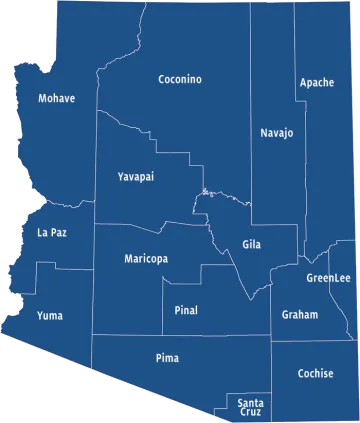Arizona Metro Areas
Compare job growth in Arizona's metro areas.
Click titles on/off in the legend at the bottom of the chart to compare metro areas.
Explore indicators for Arizona’s seven metro areas.
These links take you to EBRC's Arizona's Economy website.
- Flagstaff MSA (Coconino Co.)
- Lake Havasu City-Kingman MSA (Mohave Co.)
- Phoenix-Mesa-Glendale MSA (Maricopa+Pinal Co.)
- Prescott Valley-Prescott MSA (Yavapai Co.)
- Sierra-Vista MSA (Cochise Co.)
- Tucson MSA (Pima Co.)
- Yuma MSA (Yuma Co.)
- Compare Employment - Western Metros
- Compare Real GDP - Western Metros
- Compare Hourly Earnings - Western Metros
MSA is the abbreviation for metropolitan statistical area. An MSA contains a core urban area of 50,000 or more in population. Geographically it consists of one or more counties and includes the counties containing the core urban area, as well as any adjacent counties that have a high degree of social and economic integration, as measured by commuting to work, with the urban core. That is, MSAs are always drawn around county boundaries. The Phoenix-Mesa-Glendale MSA, which consists of Maricopa and Pinal Counties, is the only multiple county MSA in Arizona. All other MSAs in Arizona have single county equivalents.

The relationship between Arizona's metro areas and counties.
| Arizona's Metropolitan StatistiCal Areas (MSAs) |
|---|
| Flagstaff MSA = Coconino Co. |
| Lake Havasu City-Kingman MSA = Mohave Co. |
| Phoenix-Mesa-Glendale MSA = Maricopa Co. + Pinal Co. |
| Prescott Valley-Prescott MSA = Yavapai Co. |
| Sierra Vista-Douglas MSA = Cochise Co. |
| Tucson MSA = Pima Co. |
| Yuma MSA = Yuma Co. |
| Arizona's micropolitan statistical areas |
|---|
| Nogales = Santa Cruz Co. |
| Payson = Gila Co. |
| Safford = Graham Co. |
| Show Low = Navajo Co. |
| Arizona's Non-Metro Counties |
|---|
| Apache Co. |
| Greenlee Co. |
| La Paz Co. |
Metropolitan and micropolitan statistical areas (metro and micro areas) are geographic entities defined by the U.S. Office of Management and Budget (OMB)—not the Census Bureau—for use by federal statistical agencies in collecting, tabulating, and publishing a consistent set of federal statistics. These statistical areas are not governmental entities such as cities, towns, or counties.
Definitions
A metropolitan area contains a core urban area of 50,000 or more population (abbreviated MSA for metropolitan statistical area).
A micropolitan area contains an urban core of at least 10,000, but less than 50,000, population.
Each metro or micro area consists of one or more counties and includes the counties containing the core urban area, as well as any adjacent counties that have a high degree of social and economic integration, as measured by commuting to work, with the urban core.

